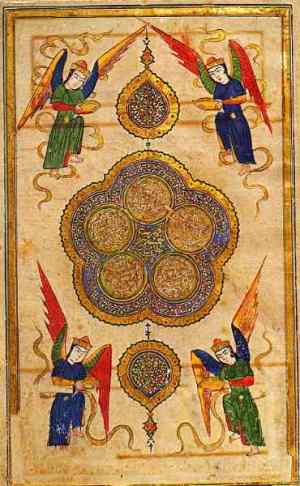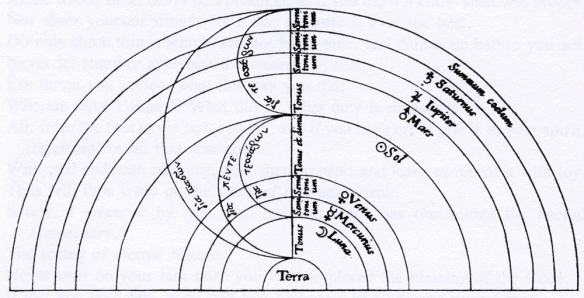This is but a cursory introduction to the Greater Bundahishn which will be followed by articles with a sharper focus. The work contains a concise narrative of the Zoroastrian creation myth, including the first conflicts between Ahura Mazda and Angra Mainyu for the hegemony of the world. In the process, the Bundahishn recites an exhaustive compendium on the nature of things, including the properties of the elements and significant astrological material. For those interested, there is a pdf version of the work here.
The Bundahishn exists in two forms, the Greater, and the Lesser. The first is the longer Persian version and the shorter or lesser is an Indian version. Here we will be discussing the former only. The title of the work translates as ‘primal creation” The work concerns itself with every imaginable question that might be raised about the Creation, including the origin and nature of the dark force and it’s antagonism to the light force, ultimately for a greater good. Compared to comparable works, such as Genesis, it is concise, to the point and quintessentially Persian in its optimistic point of view, even in the face of cosmic adversity. Although the work is late, almost certainly the ninth century, it harks back to the ancient religion of Zarathustra.
As stated by the author at Encyclopedia Iranica, “it’s a major Pahlavi work of compilation, mainly a detailed cosmogony and cosmography based on the Zoroastrian scriptures but also containing a short history of the legendary Kayanids and Ērānšahr in their days. There is also a Ṣad dar-e Bondaheš, a considerably later (ca. 8th-9th/14th-15th century) work in Persian of a hundred miscellaneous chapters on the Zoroastrian religion, morals, legends, and liturgy.” (Encyclopedia Iranica)
As David Pingree has observed, “the Sassanian horoscope is quite different from the normal Greek Thema Mundi. with which it has been compared.” (Masha’allah: some Sasanian and Syriac sources. pp. 5) The most immediately noticeable feature of the Sassanian horoscope is that it is diurnal, with Aries, the exaltation of the Sun occupying the tenth house, rather than the Sun with Leo in the second house in the diurnal Thema Mundi. Instead of the planets and luminaries being placed in their respective domiciles, they take the place of their exhalations. However, there are some interesting anomalies. The Ninth House is occupied by the sign Pisces with Venus and Mercury, the first is exalted in Pisces, but Mercury falls in the sign of the Fishes.
The degrees assigned to the signs and planets is crucial to the overall meaning. We know that Persians translated Greek astrological material. Less often mentioned is the influence of Indian astrology.
The Ascendant is in Cancer at the same degree as Sirius, “know as Tishtar in the Khurta (Lunar constellation) Azrarag, which corresponds to the Indian naksatra, Aslesa [9th of the 27 nakshatras in Hindu astrology.] (Cancer 16;40° – 30°)” Pingree p. 5-6.
The other most striking difference is in relation to the nodes, in the exaltation but occupying the unfortunate houses. The house of the Evil Spirit is given to the North Node (Rahu) and Gemini. The S. Node (Ketu) is given to Sagittarius.
However, the exaltation of the Sun in Aries is shown at 19° which concords with the Greek assignment. The Indian degree of exaltation is 9°. The Persian sources appear to be troubled by the Sun being in a nocturnal chart of creation. This makes perfect sense considering the importance and symbolism of the Sun in indigenous Persian religion. The Lunar Mansions and Fixed Stars clearly play a role in the placement of the planets and luminaries but beyond that, we need to refer to the Persian accounts of Creation.
The Hermetic Thema Mundi is an astrological teaching tool and it is also decidedly Platonic in its expression of a perfect world of the Forms to be referred to for those who practise astrological divination. It may very well be more than that, but the Sassanian version is something quite different. It appears, after all, in a text describing every element of creation, according to ancient Persian and specifically Zoroastrianism cosmology:
“According to the spherical model assumed in Sasanian Iran under the impact of Greek and Indian astral sciences, the inferior sphere was called the spihr ī gumēzišnīg “sphere of mixture;” it comprised the twelve constellations (Pahl. 12-axtarān) which were subjected to the “mixture” with the demoniac and evil forces (planets, falling stars, comets, etc.); this sphere, of course, included the Zodiacal belt (see Ir. Bd., II, 8-9; cf. Henning, 1942, pp. 232-33, 240; Belardi, 1977, pp. 125-26) with its 12 constellations (Gignoux, 1988); here a most important battle between astral demons and divine star beings takes place, according to the Pahlavi sources. In the framework of the fight between stars and planetary demons, the Zodiacal constellation were considered as bayān, in its early meaning of “givers” of a good lot in opposition to the planets, who are “bandits” (gēg) and robbers of the human fortune.” (Encyclopedia Iranica)
The Greater Bundahishn is a compendium of ideas that are believed to pre-date Zoroastrianism, but the core is true to the cosmology of that religion. There are also some elements that would indicate knowledge relatively contemporary to its ninth century appearance. It appears to be putting preserved knowledge in one place after the horrific destruction in the wake of the Islamic invasion.

























